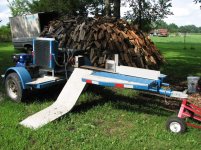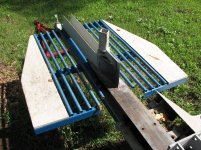You are using an out of date browser. It may not display this or other websites correctly.
You should upgrade or use an alternative browser.
You should upgrade or use an alternative browser.
Help! homebuilt log splitter
- Thread starter AnthonyGarcia
- Start date
/ Help! homebuilt log splitter
#11
Don't know exactly if this is what you are looking for, but I'd reverse and put the wedge on the solid end. That way you can use it for the prop all by itself, and the ram be the "push" end.
unless i misread, he said the the splitter pivots vertical. with the splitter vertical you have to have the wedge attached to the ram or else you'd be trying to drive the stick into the ground when you push.
i'm sure you didn't do this, but i have to ask: can you extend the ram fully without the wedge contacting the plate at the end? i'm surprised that that much stuff bent without the wood just jumping out of the splitter long before bending that far.
grsthegreat
Super Star Member
unless i misread, he said the the splitter pivots vertical. with the splitter vertical you have to have the wedge attached to the ram or else you'd be trying to drive the stick into the ground when you push.
i'm sure you didn't do this, but i have to ask: can you extend the ram fully without the wedge contacting the plate at the end? i'm surprised that that much stuff bent without the wood just jumping out of the splitter long before bending that far.
ya, good thought. If i extend my ram fully, theres still a 2" gap between the wedge and the base plate.
Short Game
Veteran Member
Though I agree with wrapping the wedge base plate around the web of the beam, it was probably when the foot plate failed that the wedge base climbed up and bent the base plate. It looks like the thin angle tracks bent a little too. Where's the beef?
For me, a splitter that didn't pivot to vertical would be pretty much useless.
For me, a splitter that didn't pivot to vertical would be pretty much useless.
OP
AnthonyGarcia
New member
- Joined
- Oct 23, 2011
- Messages
- 4
- Tractor
- John Deere 5103 4wd
The ram cant reach the base plate by about 2", so has never hit it directly
this damage was all done in the first afternoon within the first couple dozen of splits.
when we built, we kept thinking '30 tons... it ought to do some good old Missouri hedge'
so we started off with just mid sized oak (it was all frozen), then after about a half hour, we got brave and progressed to the hedge... which it did well at first, but when it split it would pop rather violently out, then when put a piece of larger sized hedge and she bent to most of what you see. i needed to split a bunch of wood at that point, so i made a make shift wedge to hold wood in and just split the frozen oak from there on, for next couple hrs. that finished it to what you see now. She sat that way from then till this fall, when i decided i better get this thing fixed for the season.
So much for all our bragging while building it... the hedge had the last laugh :laughing:
Anthony
this damage was all done in the first afternoon within the first couple dozen of splits.
when we built, we kept thinking '30 tons... it ought to do some good old Missouri hedge'
so we started off with just mid sized oak (it was all frozen), then after about a half hour, we got brave and progressed to the hedge... which it did well at first, but when it split it would pop rather violently out, then when put a piece of larger sized hedge and she bent to most of what you see. i needed to split a bunch of wood at that point, so i made a make shift wedge to hold wood in and just split the frozen oak from there on, for next couple hrs. that finished it to what you see now. She sat that way from then till this fall, when i decided i better get this thing fixed for the season.
So much for all our bragging while building it... the hedge had the last laugh :laughing:
Anthony
Fermenter
New member
From the pic it looks a lot like a welded join that has given way, as others have said a solid plate would be the go, even reinforced if you're keen.
Does this splitter operate vertically? If not, then why not weld a blunt wedge (eg 90deg) to the bed? That way you avoid concentrating all the force onto a single lateral join, and it will probably split more effectively too.
Does this splitter operate vertically? If not, then why not weld a blunt wedge (eg 90deg) to the bed? That way you avoid concentrating all the force onto a single lateral join, and it will probably split more effectively too.
Oliver1655
Gold Member
- Joined
- Jun 25, 2010
- Messages
- 251
- Tractor
- Oliver 1655
I understand your desire to have a "Muscle" splitter for hedge, but even if you go down to a 2,500 psi pressure relief setting on your valve, you should have no problem with hedge, elm, or anything else. I have a basic 4" x 24" tie rod cylinder with an 1 1/2" ram, a 2,500 psi valve, & 16 gpm Haldex 2 stage pump, (approximately 15.6 ton) and have no problem splitting 3' rounds of hedge. (I have a log lift on my splitter, it is a dedicated horizontal with a sharp fixed wedge, & out feed tables.) I like being able to work at table height. Once the rounds have been picked up I don't let them hit the ground again until they are put in the wood pile or shed. PS - I also live in mid Missouri.
Attachments
ovrszd
Epic Contributor
- Joined
- May 27, 2006
- Messages
- 33,499
- Location
- Missouri
- Tractor
- Kubota M9540, Ford 3910FWD, Ford 555A, JD2210
(I have a log lift on my splitter, it is a dedicated horizontal with a sharp fixed wedge, & out feed tables.) I like being able to work at table height. Once the rounds have been picked up I don't let them hit the ground again until they are put in the wood pile or shed. PS - I also live in mid Missouri.
Us Missourians must think alike. I'm the same way. I prefer a horizontal splitter with log lift and catch rack. That allows me to roll the huge ones on the lift, then I work standing and rarely pick up a split piece off the ground.
When I built my 3pt splitter I tilted the wedge slightly forward at the top. This stopped the log from trying to ride up the wedge as it split.
I also set my cylinder low at the wedge/push block end, high at the fixed end. This creates downforce as it pushes. Takes a lot of stress off the system used to hold the wedge/push block against the I-beam.
Short Game
Veteran Member
My neighbor had a knotty 54 inch spruce tree taken down that was threatening his house. I bucked it for him and we moved the rounds into his yard (one at a time in the bucket). I doubt I would have liked lifting those rounds up over my body to get them onto a horizontal splitter. We laid them out like so many tiddlywinks, put my splitter into the upright position, and I would drive the splitter foot (a railroad tie iron) under the rounds in place and we busted all those rounds on the ground. I built my splitter to mount on the end of the box blade. So, even if I can't move the round, I can move the splitter instead. The round in the picture is only about 28 inches. But many of the bigger rounds I deal with here are not round like wheels and can be pretty lumpy as well. They would be difficult to get in place with a lift. My splitter is balanced such that even with my light wimpy old body I can tip it either way. Anyway, this setup has worked out very well for me.

Once that round was quartered, the pieces were easy to lift for horizontal operation.


Once that round was quartered, the pieces were easy to lift for horizontal operation.

For me, a splitter that didn't pivot to vertical would be pretty much useless.
kind of off track, but... for any of us without a log lift on our splitter, we do need a way to get the heavy rounds to the wedge. since i use a 3 point splitter, i opted to make my beam fixed, and i just lower the three point to ground level and roll on the real heavy rounds to break them into manageable pieces, then pull the hitch back to height.. i decided that would be easier than a vertical option. the construction isn't much different, but fixed wedge is a little simpler to build.

